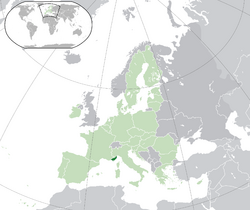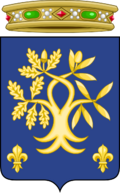Pasantia: Difference between revisions
No edit summary |
|||
| Line 151: | Line 151: | ||
==Geography== | ==Geography== | ||
Pasantia consists of a small stretch of land which surmounts to a total area of 14,822 km2. It borders {{Wp|France}} {{Wp|Italy}} to its north and the {{Wp|Mediterranean sea}} to its south. In terms of topography Pasantia is largely dominated by the continuation of the {{Wp|Maritime Alps}} which make up most of the northerly borders where the nation meets France and Italy before plunging into the middle of the country making the centre of Pasantia a landscape | Pasantia consists of a small stretch of land which surmounts to a total area of 14,822 km2. It borders {{Wp|France}} {{Wp|Italy}} to its north and the {{Wp|Mediterranean sea}} to its south. In terms of topography Pasantia is largely dominated by the continuation of the {{Wp|Maritime Alps}} which make up most of the northerly borders where the nation meets France and Italy before plunging into the middle of the country making the centre of Pasantia a landscape of high mountains and dramatic valleys. The tallest mountain in Pasantia located within this range which are called the ''Nuvoli'' is called Diula which sits at 2,109m. As you go further west the Nuvoli give way to the less dramatic ''Piccula'' range which on average are much less tall at around 300-400m. The rivers {{Wp|Roya (river)|Roya}} and {{Wp|Rhône}} carve wide spectacular valleys through the mountains on their way to the Mediterranean. Here the Rhône delta in the south of the country where one of the nation's main port cities Roussa sits is much flatter and much more populated than the highland interior. In the West as the Piccula mountains decrease even more in stature there is a plain of flatter more viable agricultural land where a majority of the Pasantian population reside. Here in the south west about 20km inland the heart of the nation, its capital [[Leonora]] lies although in modern times it has grown and spread and incorporated coastal towns and now boasts one of the Mediterranean's largest ports. | ||
The Pasantian coast is famous for its {{Wp|Calanque|Calanques}} known as ''Calanci'' in Pasantian. These are towering {{Wp|Limestone}} inlets which punctuate the Pasantian | The Pasantian coast is famous for its {{Wp|Calanque|Calanques}} known as ''Calanci'' in Pasantian. These are towering {{Wp|Limestone}} inlets which punctuate the Pasantian coastline and are amongst the most well known and loved images of the country. A majority of Pasantia is made up of {{WP|Mediterranean forests, woodlands, and scrub}} this is best seen in the Epesa national forest which boasts vegetation such as {{Wp|Sclerophyll}} and {{Wp|Oak}} as well as areas of {{Wp|Conifer}}. There are also wide areas of scrubland and grasslands. | ||
==Politics== | ==Politics== | ||
Revision as of 20:40, 13 March 2024
Republic of Pasantia A Republica Pasantia | |
|---|---|
 | |
| Location | Pasantia (Dark Green) In Europe (Light Green and dark grey) in the European Union (light green) |
| Capital | Leonora |
| Official languages | Pasantian |
| Recognised regional languages | French, Italian, Corsican |
| Demonym(s) | Pasantian |
| Government | Unitary parliamentary republic |
• President | Chiara Rossi |
• Prime Minister | Elena Luciani |
| Legislature | Parliament |
| Senate | |
| Chamber of Deputies | |
| Area | |
• | 14,922 km2 (5,761 sq mi) (149th) |
| Population | |
• 2023 estimate | 1,775,822 |
• Density | 119/km2 (308.2/sq mi) |
| GDP (PPP) | 2024 estimate |
• Total | $52.605 billion (121st) |
• Per capita | $54,320 (30th) |
| GDP (nominal) | 2024 estimate |
• Total | $33.102 billion (107th) |
• Per capita | $35,024 (29th) |
| Gini | 29.8 low |
| HDI (2024) | very high |
| Currency | Euro (EUR) |
| Time zone | CET |
| Date format | dd/mm/yyyy |
| Driving side | right |
| Calling code | +395 |
| ISO 3166 code | PAS |
| Internet TLD | .pas |
Pasantia officially the Republic of Pasantia is a country in southern and western Europe located on the coast of the Mediterranean Sea it borders France and Italy to the north. It consists of continental Pasantia which is largely an extension of the Maritime Alps which cover most of its northerly borders with france and Italy as well as a great deal of the east of the country. The river Roya flows through the centre of the nation before draining into the Mediterranean. The largest Pasantian island is Verduré which is situated just off the south western coast. It is the 149th largest country in the world covering a total land area of 14,922 km² (5,761 sq mi). Pasantia is a member of the European Union and the Union for the Mediterranean. The capital and largest city in Pasantia is Leonora which is located about 20km inland in the west of the country.
Pasantia has been inhabited since the Mesolithic era where peoples there settled on the Mediterranean coast divided in to several tribes known as the Pasanti named after the Pasanti valley spread throughout Rhône, the Roya and Tevrena valleys where modern day Pasantia is now.
The city of Leonora was founded in the 4th millennium BC and had trade routines connected to Genoa, the Greeks and Estruscans. Eventually Leonora and its hinterland came under the influence of Rome.Augustus made Leonora and the lands where the Pasanti lived a region of Italy. During this time provincial towns were founded and Leonora received an increase in trade and prosperity. Roman roads were built in Pasanti lands and the region flourished. There were rebellions from local Pasanti tribes suppressed by the romans during this time as well around 50 BC coinciding with the Gallic Wars. In the intervening years Pasantia would come under the influence of Byzantines and Lombards and the influence of Leonora soon led to it becoming a city state in its own right as it annexed the port of Dulona giving it prized access to the sea. Pasantia had been Christianised in the 3rd century by missionaries from Rome.
The Republic of Leonora was founded in the 11th century and quickly expanded amidst political and economic success spreading to control territory in Sardinia and Corsica. It competed with the Republic of Genoa and other fiefs inland. The Republic of Leonora became a hugely influential and important Mediterranean maritime might between the 11th and 14th centuries. The Republic soon annexed most of what is modern Pasantia and what was then known as the fiefdoms of Tervia and the Maquis of Gerale.
In the early modern period the Kingdoms of France and Spain both played a heavy hand in the influencing of the Republic at times destabilising its political structures and leading to crisis. In the 1790s the Republic of Leonora was reformed into the Republic of Pasantia by Napoleon in an area that covered the continental portion of the old city states territory. This was a Directorial republic however the first French empire annexed the republic in 1805. Following the Congress of Vienna Pasantia was once again reformed after threat of a Pasantian uprising should Pasantia be included in the territory of France or Sardinia.
In the 19th century Pasantia industrialised rapidly and saw huge economic growth as the port of Dulona and the cities of Leonora and Tervia exploded in industrial growth, wealth and commerce. Pasantia became a hub of Mediterranean and southern European industry. Disparities quickly grew between the more conservative countryside and radical cities. These divisions largely exist today. In the Second World War although officially neutral Pasantia was occupied by Italian and then later German soldiers. Passive and aggressive resistance to this occupation was widespread. Pasantia was liberated by American troops in August 1944.
In the years following the war and the decades after Pasantia became a hotspot for tourism in Europe and around the world, known for its warm climate, beautiful architecture, unique culture and great cuisine. New high speed rail connections to Leonora to Paris and the rest of Europe brought new growth and prosperity to the country and its entry into the European Union extended this growth and saw Pasantia become an important part of the European political and economic framework.
Etymology
History
Geography
Pasantia consists of a small stretch of land which surmounts to a total area of 14,822 km2. It borders France Italy to its north and the Mediterranean sea to its south. In terms of topography Pasantia is largely dominated by the continuation of the Maritime Alps which make up most of the northerly borders where the nation meets France and Italy before plunging into the middle of the country making the centre of Pasantia a landscape of high mountains and dramatic valleys. The tallest mountain in Pasantia located within this range which are called the Nuvoli is called Diula which sits at 2,109m. As you go further west the Nuvoli give way to the less dramatic Piccula range which on average are much less tall at around 300-400m. The rivers Roya and Rhône carve wide spectacular valleys through the mountains on their way to the Mediterranean. Here the Rhône delta in the south of the country where one of the nation's main port cities Roussa sits is much flatter and much more populated than the highland interior. In the West as the Piccula mountains decrease even more in stature there is a plain of flatter more viable agricultural land where a majority of the Pasantian population reside. Here in the south west about 20km inland the heart of the nation, its capital Leonora lies although in modern times it has grown and spread and incorporated coastal towns and now boasts one of the Mediterranean's largest ports.
The Pasantian coast is famous for its Calanques known as Calanci in Pasantian. These are towering Limestone inlets which punctuate the Pasantian coastline and are amongst the most well known and loved images of the country. A majority of Pasantia is made up of Template:WP this is best seen in the Epesa national forest which boasts vegetation such as Sclerophyll and Oak as well as areas of Conifer. There are also wide areas of scrubland and grasslands.


